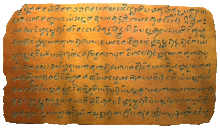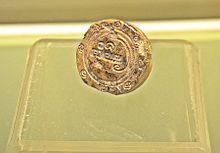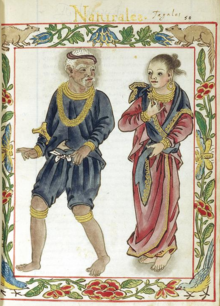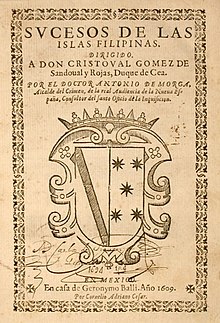Baybayin is a Philippine script. The script is an abugida belonging to the family of the Brahmic scripts. Geographically, it was widely used in Luzon and other parts of the Philippines prior to and during the 16th and 17th centuries before being replaced by the Latin alphabet during the period of Spanish colonization. It was used in the Tagalog language and, to a lesser extent, Kapampangan-speaking areas; its use spread to the Ilocanos in the early 17th century. In the 19th and 20th centuries, baybayin survived and evolved into multiple forms—the Tagbanwa script of Palawan, and the Hanuno'o and Buhid scripts of Mindoro—and was used to create the constructed modern Kulitan script of the Kapampangan and the Ibalnan script of the Palawan people. Under the Unicode Standard and ISO 15924, the script is encoded as the Tagalog block.
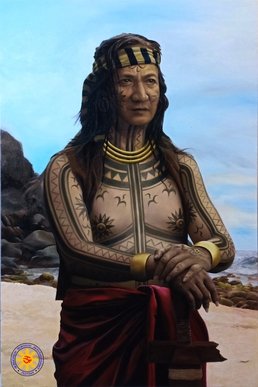
Lapulapu or Lapu-Lapu, whose name was first recorded as Çilapulapu, was a datu (chief) of Mactan in the Visayas in the Philippines.

The Laguna Copperplate Inscription is an official acquittance certificate inscribed onto a copper plate in the Shaka year 822. It is the earliest known calendar-dated document found within the Philippine Islands.
Rajah Humabon, later baptized as Don Carlos, was a King of Cebu in the 16th century.

In early Philippine history, the Tagalog settlement at Tondo sometimes referred to as the Kingdom of Tondo, was a major trade hub located on the northern part of the Pasig River delta, on Luzon island. Together with Maynila, the polity (bayan) that was also situated on the southern part of the Pasig River delta, had established a shared monopoly on the trade of Chinese goods throughout the rest of the Philippine archipelago, making it an established force in trade throughout Southeast Asia and East Asia.

There have been several names of the Philippines in different cultures and at different times, usually in reference to specific island groups within the current archipelago. Even the name Philippines itself was originally intended to apply only to Leyte, Samar, and nearby islands. It was bestowed by the Spanish explorer Ruy López de Villalobos or one of his captains Bernardo de la Torre in 1543 in honor of the crown prince Philip, later Philip II. Mindanao, which they reached first and assumed to be the greater land, they named after the reigning emperor Charles V, who was also Spain's king Carlos I. Over the course of Spanish colonization, the name was eventually extended to cover the entire chain. It has survived with minor changes. The Philippine Revolution called its state the Philippine Republic. The US military and civilian occupations called their territory the Philippine Islands. During the Third Philippine Republic, the state's official name was formally changed to the Philippines.

The cultural achievements of pre-colonial Philippines include those covered by the prehistory and the early history (900–1521) of the Philippine archipelago's inhabitants, the pre-colonial forebears of today's Filipino people. Among the cultural achievements of the native people's belief systems, and culture in general, that are notable in many ethnic societies, range from agriculture, societal and environmental concepts, spiritual beliefs, up to advances in technology, science, and the arts.
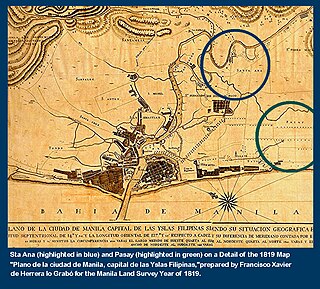
Namayan, also called Sapa, Maysapan, and sometimes Lamayan, was an independent indigenous polity on the banks of the Pasig River in the Philippines. It is believed to have achieved its peak in 1175, and to have gone into decline sometime in the 13th century, although it continued to be inhabited until the arrival of European colonizers in the 1570s.
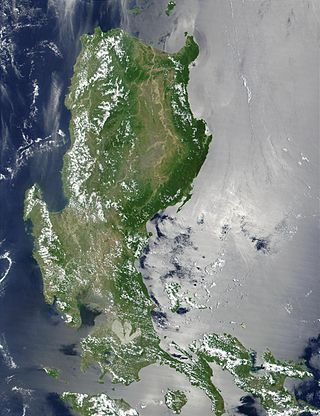
Luzones was a demonym used by Portuguese sailors in Malaysia during the early 1500s, referring to the Kapampangan and Tagalog people who lived in Manila Bay, which was then called Lusong. The term was also used for Tagalog settlers in Southern Tagalog region.

In Philippine history, the Tagalog bayan of Maynila was one of the most cosmopolitan of the early historic settlements on the Philippine archipelago. Fortified with a wooden palisade which was appropriate for the predominant battle tactics of its time, it lay on the southern part of the Pasig River delta, where the district of Intramuros in Manila currently stands, and across the river from the separately-led Tondo polity.

The known recorded history of the Philippines between 900 and 1565 begins with the creation of the Laguna Copperplate Inscription in 900 and ends with the beginning of Spanish colonization in 1565. The inscription records its date of creation in the year 822 of the Hindu Saka calendar, corresponding to 900 AD in the Gregorian calendar. Therefore, the recovery of this document marks the end of the prehistory of the Philippines at 900 AD. During this historical time period, the Philippine archipelago was home to numerous kingdoms and sultanates and was a part of the theorized Indosphere and Sinosphere.

In early Philippine history, barangay is the term historically used by scholars to describe the complex sociopolitical units which were the dominant organizational pattern among the various peoples of the Philippine archipelago in the period immediately before the arrival of European colonizers. Academics refer to these settlements using the technical term "polity", but they are usually simply called "barangays."
Religion in pre-colonial Philippines included indigenous religious beliefs and mythologies, some of which are still practiced today, particularly by the various indigenous peoples of the Philippines. In many Filipino cultures, these beliefs were later influenced by Hinduism and Buddhism. With the arrival of Islam in the 14th century, the older religions gradually became less dominant, and after the arrival of Ferdinand Magellan in 1521 Christianity, specifically Catholicism, became the dominant religion. However, many of the indigenous religious traditions have survived in the form of Folk Catholicism and Folk Islam.

The history of Luzon covers events that happened in the largest island of the Philippine Archipelago, Luzon. Luzon wrested the record of having the oldest man ever discovered in the Philippines with discovery of the Callao Man in 2007, which predated the Tabon Man by around 20,000 years. The written history of Luzon began in around 900 AD with the discovery of the Laguna Copperplate Inscription in 1989. After that, Luzon began to appear in the annals of the Chinese and Japanese. One example would be the Ming Shilu, wherein Luzon appeared in 22 records. Luzon was split among Hindu-Buddhist kingdoms, Muslim principalities, and ethnoreligious tribes, who had trading connections with Borneo, Malaya, Java, Indochina, India, Okinawa, Japan and China before the Spanish established their rule. As a result of the Spanish–American War, Luzon became American territory. In the Second World War, Luzon saw one of the fiercest battles during the Japanese occupation. Luzon, apart from being the largest island, had been the economic and political center of the Philippines ever since the country entered the Western Calendar, being home to the country's capital city, Manila, and the country's largest metropolis, Metro Manila.
Malay is spoken by a minority of Filipinos, particularly in the Palawan, Sulu Archipelago and parts of Mindanao, mostly in the form of trade and creole languages, such as Sabah Malay.
The Indian influences in early Philippine polities, particularly the influence of the Srivijaya and Majapahit thalassocracies on cultural development, is a significant area of research for scholars of Philippine, Indonesian, and Southeast Asian history, and is believed to be the source of Hindu and Buddhist elements in early Philippine culture, religion, and language. Because the Indonesian thalassocracies of Srivijaya and Majapahit acquired many of these Hindu and Buddhist elements through Indianization, the introduction of such elements to early Philippine cultures has sometimes been referred to as indianization. In more recent scholarship, it is termed localization, as in, e.g., localization of Hindu and Buddhist beliefs. Some scholars also place the Philippine archipelago within the outermost reaches of the Indosphere, along with Northern Vietnam, where the Hindu and Buddhist elements were not directly introduced by Indian travellers.

The term Paramount Ruler, or sometimes Paramount Datu, is a term used by historians to describe the highest ranking political authorities in the largest lowland polities or inter-polity alliance groups in early Philippine history, most notably those in Maynila, Tondo, Pangasinan, Cebu, Bohol, Butuan, Cotabato, and Sulu.
The historiography of early Philippine settlements is the academic discipline concerned with the studies, sources, critical methods and interpretations used by scholars to understand the history of settlements in early Philippine history. By modern definitions, this does not involve a story of "events in the past directly," but rather "the changing interpretations of those events in the works of individual historians."
900 in the Philippines details events of note that happened in the Philippines in the year 900.

